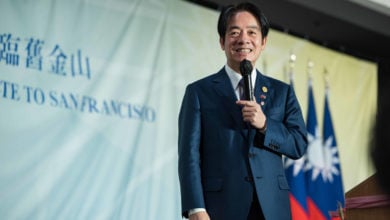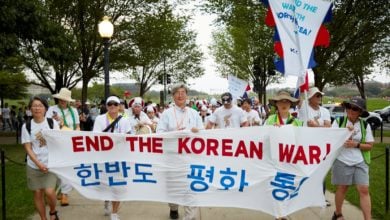On February 12, the Democratic People’s Republic of Korea (DPRK) successfully tested the Pukguksong-2, an intermediate range ballistic missile, firing it into the East Sea. The test should not have been a surprise, as Kim Jong-Un publicly announced plans for a missile test more than a month earlier.
Like almost anything the country does, it was met with immediate condemnation from the mainstream media and the imperialist governments and their institutions. A spokesperson for UN Secretary General António Guterres issued a statement accusing the DPRK of violating Security Council resolutions, demanding that the country “return to full compliance with its international obligations and to the path of denuclearization.”
This is a markedly different response than that which greeted the U.S. Air Force in September 2016, when they tested an intercontinental ballistic missile—with a range 12 times greater than the DPRK’s missile—by firing it into the Pacific Ocean. There was no international condemnation. The UN wasn’t up in arms. They didn’t insist that the U.S. was behaving recklessly. They didn’t use it as an opportunity to point out that the U.S. is clearly in violation of the Nuclear Non-Proliferation Treaty.
To point out this hypocrisy is just to scratch the surface of what is really at issue in both the discrepancy of the “international community’s” response and the “North Korean threat” to which it is allegedly responding. For while the DPRK is presented in the Western media as irrational, unpredictable, and provocative, the reality is precisely the opposite.
Trump’s Pacific provocations
After filling up his cabinet with generals, one of Trump’s first presidential memoranda concerned “rebuilding” the U.S. military. The memorandum directed Secretary of Defense James Mattis to “assess readiness conditions,” and to submit a report within 60 days that identifies “actions that can be implemented within the current fiscal year and that are necessary to improve readiness conditions.”
Less than a week later, Mattis went on his first official trip abroad, stopping first in South Korea and the next day in Japan. While in South Korea, Mattis confirmed the Trump administration’s commitment to implementing the controversial Terminal High Altitude Area Defense system (THAAD), a U.S.-designed anti-missile system that will ostensibly be aimed at the DPRK, but that could also be turned on China and Russia. Mattis said that the Trump administration is making the northwest Pacific “a priority.”
In Japan, Mattis told Prime Minister Abe Shinzo that the Trump administration would stand by the U.S.-Japan security treaty, highlighting Article 5, its mutual defense clause. Mattis denounced North Korean “provocations,” and also condemned China’s presence in the South and East China Seas. Mattis assured Japan that it would defend the Japanese occupation of the Diaoyu Islands—which Japan annexed from China in 1895—in the East China Sea.
Abe is a man after Trump’s own heart. Deeply nationalistic and militaristic, Japan under his leadership has increased military spending five times since 2012. In July 2014, the Japanese government approved a reinterpretation of Article 9 of the Japanese Constitution, which is popularly known as its “pacifism clause,” to grant more power to its armed forces.
The situation is South Korea is more complex. Current President Park Geun-hye has had her powers suspended and is facing impeachment proceedings, after months of truly massive sustained street demonstrations across the country. She will likely be impeached by March.
There would then be new elections later in the year, as early as May. Prime Minister Hwang Kyo-ahn, who has been empowered in the face of Park’s trial, supports THAAD. Moon Jae-in, likely candidate of the main opposition party, has not spoken out against THAAD, but has been a bit more measured in his approach, suggesting that it could be a bargaining chip in negotiations with China, or that it could be deferred the National Assembly.
A measured and rational response
The Trump administration’s latest moves do not represent an aberration from U.S. foreign policy, but rather an acceleration of it. This was no doubt a grave disappointment to those who hoped that Trump’s isolationist campaign trail rhetoric would mean a retreat of U.S. imperialism from the region.
There are currently around 50,000 U.S. troops stationed across 23 military bases in Japan. In South Korea, there are around 28,000 U.S. troops stationed across 15 military bases.
Together, the U.S. and South Korean armies routinely conduct so-called “war games” right on the DPRK’s border and shorelines. There were two rounds of joint military drills in 2016, one in March and one in August-September. The second round of military drills included the simulated pre-emptive bombing of North Korea and the “decapitation” of the government’s leadership. The next round of war games are scheduled to begin next month.
This is the situation facing the people of North Korea. The most powerful military in history is stationed right at its border. Having refused to sign a peace treaty for over 60 years, the U.S. remains technically in a state of war against the DPRK. Given this, it has hard to see the recent missile launch as anything other than a measured, rational response to U.S. aggression.
Can one even imagine what the U.S.’s response would be were the situation reversed, if the DPRK had 28,000 troops stationed on the Mexico border, and was conducting the simulated bombing of key targets in the U.S.?
North Korea has never invaded, bombed, or otherwise waged war against the United States or against any other country. It has no foreign military bases. It has no warships patrolling anywhere outside of its own territories. It has no drone program. It has never used a nuclear weapon. And not only does its nuclear arsenal pale in comparison with the United States’, but in recent years the DPRK has shifted resources away from military development.
From Songun to Byungjin
In 2013 the Central Committee of the governing Korean Workers’ Party adopted the byungjin paradigm, or parallel policy, which emphasized the dual development of the military and economy. Byungjin replaced the songun, or military first line, that had been in effect officially since 1995 and unofficially since the early 1960s.
Byungjin was further entrenched in June 2016 at the 13th Supreme People’s Assembly, the legislative body of the country that consists of 687 elected representatives (one from each constituency) who each serve five-year terms.
During the fourth session of the Assembly, the National Defense Commission was dissolved and replaced with the State Affairs Commission. While the former body prioritized—but did not focus exclusively on—military development, the latter prioritizes state economic development, and is tasked with the implementation of the latest five-year plan. Significantly, the State Affairs Commission has more representatives from the government and Korean Workers’ Party, and fewer from the army.
In other words, the 2016 Supreme People’s Assembly instituted a transition of state control away from the army and toward the Korean Workers’ Party.
The real threat to stability
What, then, is the reason for the U.S.’s aggressive maneuvers on the peninsula?
There are several answers to this question. For one, the DPRK defeated the U.S. in the Korean War, and has since pursued an independent path of development. In an era in which the capitalists declare that “There Is No Alternative” to neoliberal globalization, the DPRK proves otherwise. On one level, then, the U.S. hostility toward the DPRK is similar to that of Cuba, in that both represent alternative social and economic systems.
For two, the separation of Japan and South Korea from China has been a key component of U.S. strategy in the Pacific ever since the end of World War II. The “threat” of North Korea keeps this division in place and keeps China isolated from its neighbors. This strategic imperative has become increasingly important as China’s economic and political power has grown.
Relatedly, the illusion of the North Korean threat keeps the Pentagon’s war machine pumping in the Pacific. Without an “irrational” enemy, the U.S. would have little justification for its occupation of South Korea and its massive military presence in the Pacific.
Why progressives must defend independent Korea
There is a terrible legacy on the U.S. left of word-for-word parroting of the imperialist slander against Korea. Much of this is xenophobic and racist, and all of it is chauvinistic. Our task is not to tell the Korean people what to do. They don’t need our critiques or our enlightenment.
Those of us who want peace in the world, in the Pacific, and on the Korean peninsula, must fight for the preconditions to that peace: an immediate end to the occupation of South Korea, the signing of a peace treaty and the normalization of relations with the DPRK, and a halt to aggressive military maneuvers in the China Seas.
The bourgeois media and imperialist politicians constantly portray the DPRK as unpredictable and uncooperative enemy power. Yet the North Korean government has consistently demonstrated its willingness to negotiate with the U.S. The U.S., however, has just as consistently—save for a brief period in the 1990s—refused that cooperation.
The government and people of the North want nothing more than peace and stability. They will not sacrifice their independence at any cost, however, nor should they.






